 |  |
By Greg Niemann
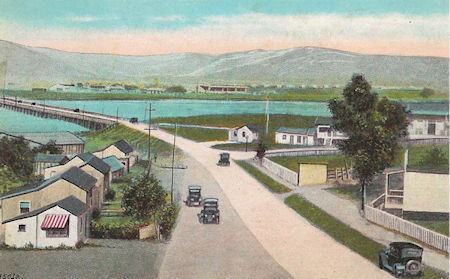
The Mexican border town of Tijuana has intrigued Americans for decades. From a small rancho, to a small town, to a thriving city, “TJ” has long welcomed its northern neighbors to its varied attractions.
A literal translation of Tia Juana means “Aunt Jane.” Several versions of the name origin are extant. For example, there was a small inn near what was then called the Corpus Christi River south of San Diego where travelers could rest and dine. It was managed by a very dynamic lady who prepared wonderful dishes and served them with grace and charm. The travelers started calling her Aunt Jane (Tia Juana).
One other suggested name source has it that an Indian chief who inhabited the Baja peninsula was named Tehuana and that’s where the name came from.
The name “Tia Juana” was in use as early as 200 years ago (1825) when the Rancho Tia Juana was granted to Don Jose Dario Arguello after the Mexican Independence.
The Arguello grant was later referred to in Cronology of Baja California by Alfonso Salazar Reynosa (1957). He noted: “It has been confirmed the rights of Santiago Arguello, a descendent of Jose Dario Arguello over the place known as Rancho Tia Juana.”
The descendent, Santiago Arguello, was actually born in the U.S. and became a U.S. citizen in 1848. He died in Tijuana in 1862.
Another reference to the Tia Juana ranch is in the Pablo Martinez book History of Baja California (1960) where he stated, “The first border was created in Tia Juana, on August 6, 1878.”
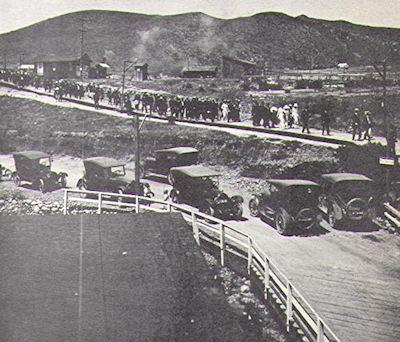
Rancho Tia Juana was baptized as a settlement on July 11, 1889, the date which marks the city’s founding and is celebrated today.
General Don Abelardo L. Rodriguez, governor of Baja California’s Northern Territory from 1923-1929, mentioned “Tia Juana” several times in correspondence. During that time in most written accounts, the “a” was somehow dropped from Tia Juana and there was no more “Aunt Jane.” The official name was finally changed to the Municipality of Tijuana on November 15, 1929.
For decades the border city of Tijuana had a reputation as an anything-goes destination. During the Roaring Twenties, Tijuana became the town for non-stop action.
Early on, Avenida Revolution was lined with nightclubs and bars, including the famous Mexicali Beer Hall. Until it was demolished to make way for the Woolworth’s department store, the Mexicali Beer Hall boasted the “World’s Longest Bar” which ran the entire length of the block-long building.
Then there were the floor shows. In post-WWII Tijuana, the wide-open town had a lot to attract young servicemen from booming southern California bases. Cheap beer and go-go joints became part of Tijuana folklore.
Visiting in the 1950s
By the 1950s Tijuana still had a sin-city image, one that lingered for well over a half century. Tijuana has come a long way since then and the early influence of racetrack gambling and a handful of strip bars has become negligible to the economy of the city.
But for a group of us teenagers back in 1956, we sought the Tijuana of folklore. As we headed south from Los Angeles in Clem’s old Studebaker, we 16- and 17-year-olds were giddy with anticipation as we embarked on our grand adventure.
At the end of the Santa Ana Freeway in Tustin the two-lane road (Now I-5) wound up and down hills, through the main streets of all the coastal towns to San Diego. Thus, it was mid-day Saturday before we approached the border.
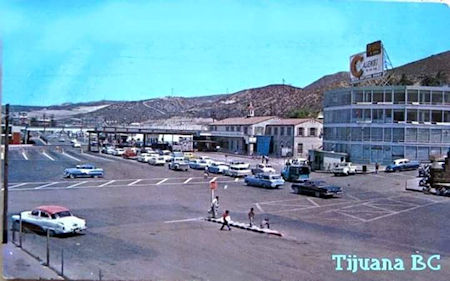
We stopped at a San Ysidro liquor store which offered free passes to Tijuana’s Caliente Racetrack. A giant pad of these promotional freebies, good for the $2 general admission at Caliente, rested on the liquor store counter. We nabbed almost the whole pad.
“Let's sell ‘em,” someone suggested.
“Great idea,” countered another. Most of us worked after-school jobs but we were always broke. Grocery store baggers and the like, our average pay was only about 75 cents an hour.
After we anxiously crossed the border, tentative and nervous because of our age or lack of it, we made the immediate obligatory right turn and crossed the Tijuana River over the old, narrow concrete bridge. That put us on Avenida Revolution, the main tourist street.
But we kept going that day, all the way out to the racetrack. We each took some coupons and stood in front of the admission gate, where a sign clearly indicated a $2 admission. As gringos walked up, we approached and offered them a half-price ticket at only $1.
While there were a few skeptics who doubted the veracity of our offer, we quickly sold most of the tickets, using the remaining few for our own admissions. The extra money also let us make a few bets on the ponies, something teenagers were not allowed to do at Hollywood Park or Santa Anita. In fact almost everything we did that weekend would be outlawed to teenagers in California. Therein was the attraction.
Tijuana was still small in the mid-1950s, centered around curio shops and those bars along the one main street. What a contrast to the vibrant city of today with shopping plazas, museums and cultural centers!
In 1921 the population of Tijuana was listed as 1,028. By 1950, 60,000, and by 1969 it had reached 350,000. In 2025 the Tijuana metropolitan area population of 2,333,000 make it Mexico’s second largest city, or almost two thirds of the state of Baja California’s populace of approximately 3.8 million. It is the third largest city on the west coast of North America and the eighth largest city in all of North America.
By 2025 some 50 million people cross the International Border at Tijuana each year as it continues to be the world’s busiest international border crossing.
While many tourists continue south to other Baja California destinations, a goodly number have been drawn to Tijuana itself. The city today offers cultural and business opportunities, shopping, varied entertainment, as well as medical/dental tourism.
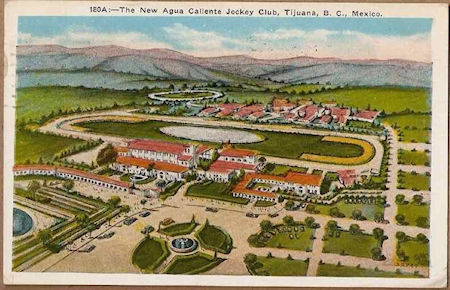
It started with Horse Racing
Americans started going to Tijuana following Mexico’s 1915 decision to legalize gambling and it started with horse racing. It wasn’t long before Prohibition in the U.S. had fun-seeking Americans flocking south to newly opened Baja resorts and casinos in addition to betting on the horses.
The Tijuana Jockey Club opened in January 1916. The initial track location was near the U.S./Mexico border and opening day’s six races drew 10,000 Californians who at the time were legally denied betting on horse racing at home.
Unfortunately, the Jockey Club was ravaged by a flood and then a fire. So in 1928/1929 American entrepreneurs built a beautiful new Agua Caliente Racetrack with adjacent casino and golf course on the then outskirts of Tijuana. Americans flocked to the new Agua Caliente complex to gamble and imbibe in spirits.
The Caliente Racetrack attracted top horses from the very beginning pioneering large purses and innovative betting. The Agua Caliente Handicap, once won by Seabiscuit, offered the largest purse in North America. The Caliente’s famous 5-10 was the forerunner to the pick-six wagers now found at most racetracks.
Baja was booming and other casinos opened or were planned.
Then came the death knell from several fronts over a four-year period:
In 1931, Nevada legalized casino gambling.
Then, in 1933, Prohibition was repealed in the U.S.
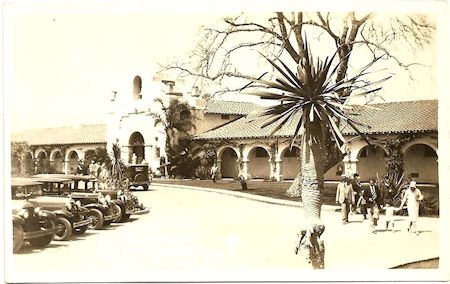
Also in 1933, California legalized pari-mutuel racetrack wagering; and the Santa Anita Racetrack opened in 1934.
But most damaging, in 1935 Mexican President Lảzaro Cárdenas decreed an end to gambling and casinos throughout Mexico, hitting Baja California hard. The lavish Agua Caliente complex faltered, then all but closed.
Back then betting on the horses was a thrilling time for us. We actually won a couple races and headed into town with a few more dollars.
The Caliente Racetrack ceased horse racing in 1992, instead only offering greyhound racing. Then last year, on July 14, 2024, Caliente also permanently terminated the greyhound racing.
The end of an exciting border-town period is complete, and the city of Tijuana has grown to offer much more. However, I’m thankful I was able to enjoy TJ in its heyday!

Easiest way to purchase insurance when traveling to Mexico. I have used their service for the last...

They are very good . There website doesn't show you need a title to bring a vehicle across the...

I'm listening to the audiobook of God and Mr. Gomez at this very minute. One of my favorite books....